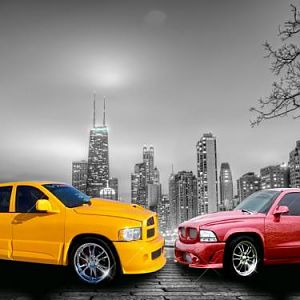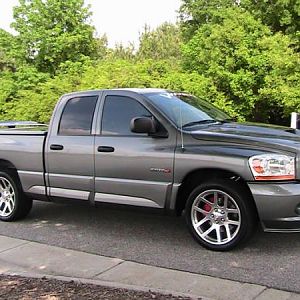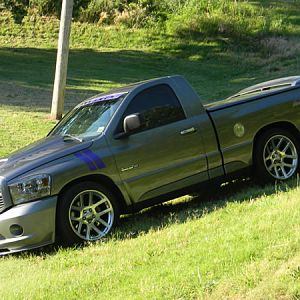If a cat is removed, the downstream O2 sensor smells it and tells the PCM to set the code and turn on the light. Other than that, in theory what else happens? Does the PCM pull fuel or timing?, somehow trying to correct for the missing cat? Does it run pig rich? OR start leaning it out? I know we can tune them and turn the light off and all that. But it would seem that without a tune, wouldn't the PCM try to adjust fuel and spark to efficiency as best as it could given the change in exhaust flow?
You are using an out of date browser. It may not display this or other websites correctly.
You should upgrade or use an alternative browser.
You should upgrade or use an alternative browser.
O2 Sensor Theory
- Thread starter 505
- Start date
Busy today but this is from the Shop Manual and may answer a few of your questions.
CATALYST MONITOR
To comply with clean air regulations, vehicles are equipped with catalytic converters. These converters reduce the
emission of hydrocarbons, oxides of nitrogen and carbon monoxide.
Normal vehicle miles or engine misfire can cause a catalyst to decay. This can increase vehicle emissions and
deteriorate engine performance, driveability and fuel economy.
The catalyst monitor uses dual oxygen sensors (O2S’s) to monitor the efficiency of the converter. The dual O2S’s
sensor strategy is based on the fact that as a catalyst deteriorates, its oxygen storage capacity and its efficiency are
both reduced. By monitoring the oxygen storage capacity of a catalyst, its efficiency can be indirectly calculated. The
upstream O2S is used to detect the amount of oxygen in the exhaust gas before the gas enters the catalytic converter.
The PCM calculates the A/F mixture from the output of the O2S. A low voltage indicates high oxygen content
(lean mixture). A high voltage indicates a low content of oxygen (rich mixture).
When the upstream O2S detects a lean condition, there is an abundance of oxygen in the exhaust gas. A functioning
converter would store this oxygen so it can use it for the oxidation of HC and CO. As the converter absorbs the
oxygen, there will be a lack of oxygen downstream of the converter. The output of the downstream O2S will indicate
limited activity in this condition.
As the converter loses the ability to store oxygen, the condition can be detected from the behavior of the downstream
O2S. When the efficiency drops, no chemical reaction takes place. This means the concentration of oxygen
will be the same downstream as upstream. The output voltage of the downstream O2S copies the voltage of the
upstream sensor. The only difference is a time lag (seen by the PCM) between the switching of the O2S’s.
To monitor the system, the number of lean-to-rich switches of upstream and downstream O2S’s is counted. The
ratio of downstream switches to upstream switches is used to determine whether the catalyst is operating properly.
An effective catalyst will have fewer downstream switches than it has upstream switches i.e., a ratio closer to zero.
For a totally ineffective catalyst, this ratio will be one-to-one, indicating that no oxidation occurs in the device.
The system must be monitored so that when catalyst efficiency deteriorates and exhaust emissions increase to over
the legal limit, the MIL will be illuminated.
CATALYST MONITOR
To comply with clean air regulations, vehicles are equipped with catalytic converters. These converters reduce the
emission of hydrocarbons, oxides of nitrogen and carbon monoxide.
Normal vehicle miles or engine misfire can cause a catalyst to decay. This can increase vehicle emissions and
deteriorate engine performance, driveability and fuel economy.
The catalyst monitor uses dual oxygen sensors (O2S’s) to monitor the efficiency of the converter. The dual O2S’s
sensor strategy is based on the fact that as a catalyst deteriorates, its oxygen storage capacity and its efficiency are
both reduced. By monitoring the oxygen storage capacity of a catalyst, its efficiency can be indirectly calculated. The
upstream O2S is used to detect the amount of oxygen in the exhaust gas before the gas enters the catalytic converter.
The PCM calculates the A/F mixture from the output of the O2S. A low voltage indicates high oxygen content
(lean mixture). A high voltage indicates a low content of oxygen (rich mixture).
When the upstream O2S detects a lean condition, there is an abundance of oxygen in the exhaust gas. A functioning
converter would store this oxygen so it can use it for the oxidation of HC and CO. As the converter absorbs the
oxygen, there will be a lack of oxygen downstream of the converter. The output of the downstream O2S will indicate
limited activity in this condition.
As the converter loses the ability to store oxygen, the condition can be detected from the behavior of the downstream
O2S. When the efficiency drops, no chemical reaction takes place. This means the concentration of oxygen
will be the same downstream as upstream. The output voltage of the downstream O2S copies the voltage of the
upstream sensor. The only difference is a time lag (seen by the PCM) between the switching of the O2S’s.
To monitor the system, the number of lean-to-rich switches of upstream and downstream O2S’s is counted. The
ratio of downstream switches to upstream switches is used to determine whether the catalyst is operating properly.
An effective catalyst will have fewer downstream switches than it has upstream switches i.e., a ratio closer to zero.
For a totally ineffective catalyst, this ratio will be one-to-one, indicating that no oxidation occurs in the device.
The system must be monitored so that when catalyst efficiency deteriorates and exhaust emissions increase to over
the legal limit, the MIL will be illuminated.
Last edited:
In addition: According to my tuner when a cat is removed, a tuning change IS required.
O2 sensors measure oxygen (really?!?) , not strictly an air-fuel ratio and that data is sent to the ecu which DOES change the pulse width (injector open time in milliseconds ) in an attempt to keep the A/F ratio at 14. 7 parts of air to 1 part fuel (the stoichiometric ratio for gasoline) .
The stink you smell when cats are removed is the unadulterated smell of your engine doing its best to run without O2 sensor input and without the ability to stay at 14.7:1.
The stink you smell when cats are removed is the unadulterated smell of your engine doing its best to run without O2 sensor input and without the ability to stay at 14.7:1.
Thank you for the kind response Ronnie. So when the downstream reads the same or similar as the upstream the computer DOES in fact pull duration out of how long the injectors are open. The downstream O2 measures the efficiency of the cat and when it deteriorates to a certain point, that downstream O2 then triggers the ECU to pull pulse width. Then it is incorrect when folks (my chevy / ford friends) say the downstream O2 only checks the cat and doesn't affect drive quality. With the cat out of there it BY DEFINITION affects drive quality and performance.
None of this is on my 10. I rescued a 2006 2500 HD with a hemi off a used car lot that has had the living crap beat out of it. It's missing the cats and setting the PO430. I've had to do the rear end, ac evap, steering rack. I'm not sure about tuning it. But I don't want it running poorly either.
Cheers. hot muggy and awful here in Central FL.
None of this is on my 10. I rescued a 2006 2500 HD with a hemi off a used car lot that has had the living crap beat out of it. It's missing the cats and setting the PO430. I've had to do the rear end, ac evap, steering rack. I'm not sure about tuning it. But I don't want it running poorly either.
Cheers. hot muggy and awful here in Central FL.
Yes, the communication between the two cats was more complex than I thought as well. The solutions for keeping the check engine light off work but that's about all.
I run with (4) B&B hi-flow cats. It's likely costing me some horsepower but that's fine. Although it revs freely and doesn't feel like and engine with restricted exhaust.
I try to remember to change the O2 sensors every 30, 000 miles or so.
I think we had our 3 weeks of summer. uncommonly humid here as well. The leaves will be changing color here pretty quick then that morbid slide into winter.
uncommonly humid here as well. The leaves will be changing color here pretty quick then that morbid slide into winter.
I try to remember to change the O2 sensors every 30, 000 miles or so.
I think we had our 3 weeks of summer.
Strapping the rear O2 sensors to the frame of the truck or using spark plug anti foulers to pull the rear O2 sensor out of the exhaust stream works to keep the check engine light out. The smell is usually only on cold starts as the PCM dumps rich fuel until to front O2 sensors warm up. The extra fuel sticks to the cat screen to trap the unburned HC until the cats heatup and burn off the HC's during normal operating temps. The front sensors do all the work while the rears confirm
Thanks brother. I can't really justify tuning it out just yet. So I'm going the anti fouler route just to calm my OCD and the CEL. lol. When are you guys going to send us some of that cool air down? We're cooking down here.
Cold will come soon enough!
Yellow Fever #319
New Member
I just installed Belanger long tube headers, a Roe Aluminum Billet Throttle Body, Snakebite exhaust kit from Venemous1, and went cat delete. Confirmed that the only reason a new tune is "needed" is to stop the check engine light from coming on due to the rear oxygen sensors no longer being connected to a catalytic converter. I bought an Oxygen Sensor Eliminator, which according to the manufacturer, "gives the Power Control Module with mimicked, fluctuating voltage signal and tricks the Power Control Module into thinking the emissions are normal. Dodge Ram SRT-10 oxygen sensor simulator will allow you to drive without cat converter and still keep the CEL off." There is NOT a need for an additional tune, though once you have headers you can really pour in the air and fuel with a new tune. It is not necessary, however, and I am going to try the Oxygen Sensor Eliminator to calm the CEL.
- Joined
- May 18, 2006
- Messages
- 27,030
- Reaction score
- 4,416
Glad you rescued her!!! Kinda like saving a pound puppyThank you for the kind response Ronnie. So when the downstream reads the same or similar as the upstream the computer DOES in fact pull duration out of how long the injectors are open. The downstream O2 measures the efficiency of the cat and when it deteriorates to a certain point, that downstream O2 then triggers the ECU to pull pulse width. Then it is incorrect when folks (my chevy / ford friends) say the downstream O2 only checks the cat and doesn't affect drive quality. With the cat out of there it BY DEFINITION affects drive quality and performance.
None of this is on my 10. I rescued a 2006 2500 HD with a hemi off a used car lot that has had the living crap beat out of it. It's missing the cats and setting the PO430. I've had to do the rear end, ac evap, steering rack. I'm not sure about tuning it. But I don't want it running poorly either.
Cheers. hot muggy and awful here in Central FL.
- Joined
- May 18, 2006
- Messages
- 27,030
- Reaction score
- 4,416
I love reading Ronnie's posts! I always learn something mechanical - at least I think I do 
You Rock Ronnie I bet you hold degrees in many subjects
I bet you hold degrees in many subjects
You Rock Ronnie
Support Us
Become A Supporting Member Today!





